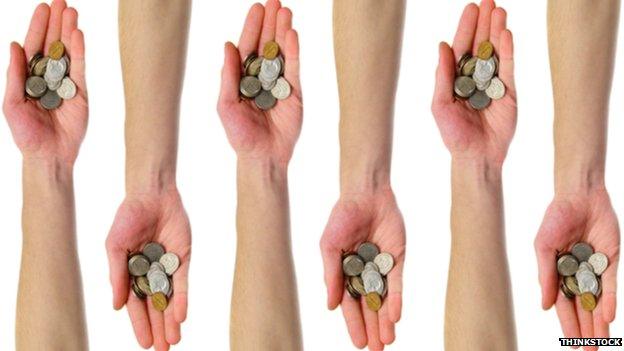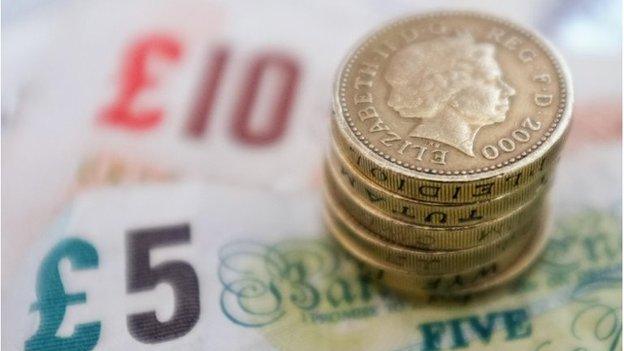Budget 2015: Will tax-free peer-to-peer lending get the go-ahead?
- Published

Peer-to-peer lenders give money to other individuals or businesses
Millions of investors who have tolerated low savings rates in cash Individual Savings Accounts (Isas) will be eager to hear what the chancellor has to say in his Budget next week.
A year ago he promised to allow peer-to-peer lending to happen within an Isa-type tax shelter, so many are expecting him to give more details of exactly how and when it could happen.
Why the excitement?
In theory, investors could double, or even treble their tax-free returns. Some are being offered interest of over 6% a year, if they put their money away for five years.
But peer-to-peer lending is a very different prospect to putting cash into an Isa. You are no longer a saver - you are more like a bank manager, who lends out money.
So, like a bank, you may find some of your borrowers just don't pay you back. Although most of the platforms offer compensation if things go wrong, you have to be prepared to lose some of your money.
Risks
The first peer-to-peer lending website, Zopa, launched back in 2005 and they are growing in popularity. Now there are 40 websites that allow investors to lend money to individuals or small businesses.

Being a peer-to-peer lender is like being a bank manager
These peer-to-peer websites can cut out the banks by putting people with money to lend in touch directly with those wanting to borrow.
In most cases it offers them the chance to secure a much better return on their money than they would get by putting it into a traditional savings account.
For Caroline White, a retired anthropology lecturer, this was not her only reason for deciding to invest in peer-to-peer lending.
"I was looking for something ethical to put money into, and the other [reason] was to look at something that would give a bit more return, a better return than I was getting in a bank savings account."
In her opinion the banks weren't really helping small businesses when she first decided to invest her money.
Another key factor behind her decision to invest was that she wanted to help the environment. One of her investments is in a renewable energy project.
'Not a savings account'
The body that represents over 90% of the alternative financial services market in the UK, the Peer-to-Peer Finance Association (P2PFA), says that £1.2bn was lent by the entire industry in 2014.
According to a recent study by the charity Nesta and the University of Cambridge, 54% of all investments were over £5,000. But you don't have to invest huge amounts.
Christine Farnish, independent chairman of the P2PFA, recommends starting small and spreading your risk.
"You can do it with as little as £10, and one of the most appealing elements is that platforms will allow you to spread your money about, so you can spread it across a lot of different types of borrowers and that makes the risk even lower."
But one expert investor didn't think enough was being done to explain the risks to consumers.
Neil Faulkner set up a comparison site last November that gives a "risk weighting" to each peer-to-peer lending scheme, and worries that some people aren't fully aware of the risks involved.
"It's not savings; it's an investment, and because it's an investment and not a saving that's what allows you to have higher rewards - but there are also higher risks too."
Rising rates
Under the Financial Services Compensation Scheme (FSCS), the first £85,000 of your savings in a bank account is protected if it goes bust. But if your investment in a peer-to-peer lending scheme goes wrong you could, in theory, end up with nothing.
In practice, most peer-to-peer lenders offer compensation if a lender fails to repay.
Zopa has its Safeguard Fund, which will give investors their money back, plus outstanding interest.
RateSetter has £12m in its Provision Fund, which has the same purpose.
But in any case default rates have declined significantly.
Last year, the overall default rate was just 0.28%, according to the P2PFA.
Another site, Funding Circle, believes the best protection is diversification, so suggests you don't lend more than 1% of your money to any one business.
However, for Darius McDermott from Chelsea Financial Services, lending isn't the only risk. He believes interest rates will eventually go up and this could put your investment in a peer-to-peer lending scheme at risk.
"If interest rates go up, mortgage rates will go up, and I think that will diminish people's ability to pay back the peer-to-peer loans."
He believes that although this will give consumers extra choice when it comes to deciding where to invest their Isa allowances, it could also create extra confusion.
- Published3 December 2014

- Published17 October 2014

- Published29 March 2014
